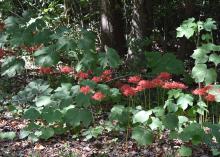Information Possibly Outdated
The information presented on this page was originally released on September 28, 2015. It may not be outdated, but please search our site for more current information. If you plan to quote or reference this information in a publication, please check with the Extension specialist or author before proceeding.
Add new texture to garden by planting Lycoris
When I was visiting Natchez looking for locations to film the TV version of Southern Gardening this past week, I had a great time enjoying the historic homes and gardens, but the sights that had me doing double takes were all the “naked ladies” parading around town.
Now, you may be thinking that I’ve been listening to too much Ray Stevens, but this is not a reference to “The Streak.” The naked or nekkid (I think this version is more fun to say) ladies I’m referring to are fabulous landscape plants that belong to the genus Lycoris.
Lycoris also has other common names like magic lily, resurrection lily and probably others. These names refer to what may seem like an odd way of growing. In the late summer and through the fall, all Lycoris varieties produce tall flower stalks without any foliage, hence the naked or magic reference. After the flowers have faded, strap-like foliage will appear to replenish the bulbs’ energy supplies, always fading away by late spring.
The flowers themselves are exotic looking and spidery. In fact, another common name is spider lily. Flower color varies by species, ranging from red, pink and white to yellow. Most varieties are hardy through at least hardiness zone 6.
I first grew Lycoris in my garden when I lived in Illinois. This was the pink-flowered Lycoris squamigera and is perhaps the most well known and most cold-hardy variety. We can’t grow this variety in the Deep South as it requires a really cold winter -- much colder than we ever experience.
A common species we see in Mississippi is Lycoris radiata. This popular Southern heirloom was the predominate plant I saw in Natchez. In the fall, its flower stalks are produced seemingly out of nowhere and are topped with a bright red azalea-like flower. I even saw a few yellow flowers scattered about.
Lycoris is easy to grow and care for. These plants need little attention as long as they are growing in a location that suits them. They are also deer and gopher resistant. It’s common to see Lycoris growing in large clumps around abandoned home sites and cemeteries. As you drive along Highway 90 on the Gulf Coast, you will see many growing where Katrina destroyed so many homes.
Order bulbs this fall and plant in a sunny landscape bed that is well drained and gets sun for about half a day. I like to dig holes for bulbs using my drill and a bulb auger. If you don’t have one of these attachments, get one. Bulb planting has never been easier. Place the bulbs rounded side down and the neck just above the soil line. Water in well, sit back and enjoy being surprised by nekkid ladies in your garden for years to come.




